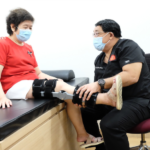Meniscal damage predicts development of accelerated knee osteoarthritis
Study data published in Arthritis Rheumatology suggest that destabilizing meniscal tears, large bone marrow lesions, and cartilage loss may predict the development of accelerated knee osteoarthritis (OA).

Emily Pond, Rheumatology Advisor January 24, 2019
Investigators selected participants from the Osteoarthritis Initiative cohort, which is composed of adults from 4 clinical sites in the United States with or at risk for symptomatic knee OA. Patients selected for the study had a knee without knee OA at baseline (Kellgren-Lawrence [KL] grade <2) and were observed for radiographic changes over 48 months.
According to radiographic criteria, 3 study groups were identified: AKOA: individuals who developed KL grade ≥3 over the study course (n=125), typical knee OA: individuals with ≥1 knee that increased radiographic scoring (n=187), and no knee OA, in which no change in KL grade was observed in either knee (n=1325).

Researchers evaluated patients for destabilizing meniscal tears, miscellaneous pathology, meniscal damage, bone marrow lesions, and damage to cartilage.
In subsequent analyses, adults with typical knee OA and no knee OA were sex-matched to adults with accelerated knee OA (n=125 per group). At each study visit, radiologists assessed patients for destabilizing meniscal tears, miscellaneous pathology, meniscal damage, bone marrow lesions, and cartilage damage.
At 1 year before the index visit, >75% of adults with accelerated knee OA had meniscal damage in ≥2 regions. At the time of the index visit, meniscal damage in ≥2 regions was “ubiquitous” in accelerated knee OA. At the index visit, 42% of patients with accelerated knee OA presented with a destabilizing meniscal tear compared with 14% of patients with typical knee OA.
Patients with accelerated knee OA had 3.19 times the odds for destabilizing meniscal pathology compared with patients with typical knee OA. Compared with adults with typical KOA, adults who developed AKOA had greater bone marrow lesion volume (P =.024) and articular cartilage loss (P <.04 for all regions). Individuals with either accelerated knee OA or typical knee OA were more likely than individuals without knee OA to have lateral meniscal pathology.
According to these results, meniscal tears, bone marrow lesions, and cartilage loss appear to differentiate individuals who develop accelerated knee OA from individuals with typical knee OA. These data may be useful to physicians in understanding patient risk for accelerated knee OA, although further research is necessary to construct a more robust predictive model.
Source Rheumatology Advisor
| References |
Accelerated Knee Osteoarthritis is Characterized by Destabilizing Meniscal Tears and Pre-Radiographic Structural Disease Burden, Driban JB, Davis JE, Lu B, Price LL, Ward RJ, MacKay JW, Eaton CB, Lo GH, Barbe MF, Zhang M, Pang J, Stout AC, Harkey MS, McAlindon TE. Arthritis Rheumatol. 2018 Dec 28. doi: 10.1002/art.40826. [Epub ahead of print]
Also see
The knee injury that some doctors still miss in Sarasota Herald-Tribune
A Female’s Aching Knees in UCSF Health
Pain Profiling May Predict Response to NSAID Plus Paracetamol in Knee Osteoarthritis in Clinical Pain Advisor






